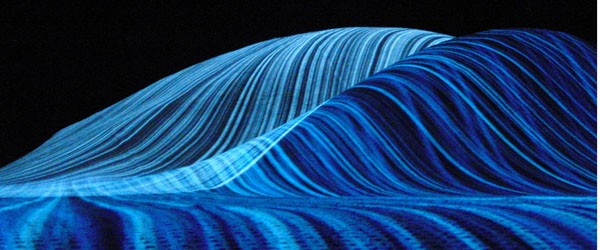Projection on forms and spaces

Theoretical background
One of the interesting differences between film and video projection is the depth of field. While film projection has a very narrow depth of field, video projection has an almost endless depth of field, so both foreground and background can be sharp at the same time. This makes it possible to project on objects/forms at various depths using the same video projector. The masterclass will explore how one projector can be used to project on several surfaces simultaneously, by dividing, in software, the projected image into several smaller images. This technique allows for instance to project on three sides of a cube using one projector, with the illusion of it coming from three different sources. When projections match the objects/surfaces they project upon, the physical forms appear to get a second "skin", either of solid color, image or video. The objects get a projected texture. By coupling this method with multihead splitting devices (e.g. Matrox dual or triplehead2go), one computer can generate visuals for 2 or 3 projectors flooding many surfaces in space.
Mapping (based on creating a virtual 3-D model of the objects/forms you want to project onto) is one of the usual approach for projecting on surfaces in space. This technique usually needs time-consuming calibrations and requires 3d rendering steps which makes it difficult to use for any realtime situation. The masterclass will explore a more flexible approach based on masking, where we work with multiple flat layers which mask individual surfaces of a form, but which are positioned, scaled and rotated in a 3d space.
Masking has many benefits when it comes to the actual process of making it, and the access to individual surfaces allows interesting video textures while giving full realtime control. Measurement or calibratation is no more needed: you place the projector and work with matching each layer to a different surface. 1
1Text based on HC Gilje research
Call for participation deadline
March 20th
Workshop / Production Lab
April 9-15th
Exhibition
April 16-17th
Workshop Fee
50 EUR
(weekend lunches + drinks included)
The masterclass is in English!
Location:
iMAL
30, Quai des Charbonnages/Koolmijnenkaai
1080 Brussels
BELGIUM
Full info here
Een archief : 1999-2010-2019
Deze pagina is een archief van de iMAL website zoals die tussen 2010 en 2019 bestond. Alle activiteiten en projecten die sinds het begin in 1999 door iMAL georganiseerd zijn zijn hier gearchiveerd.
Het meest recente nieuws en activiteiten kan je terug vinden op onze nieuwe website: imal.org
